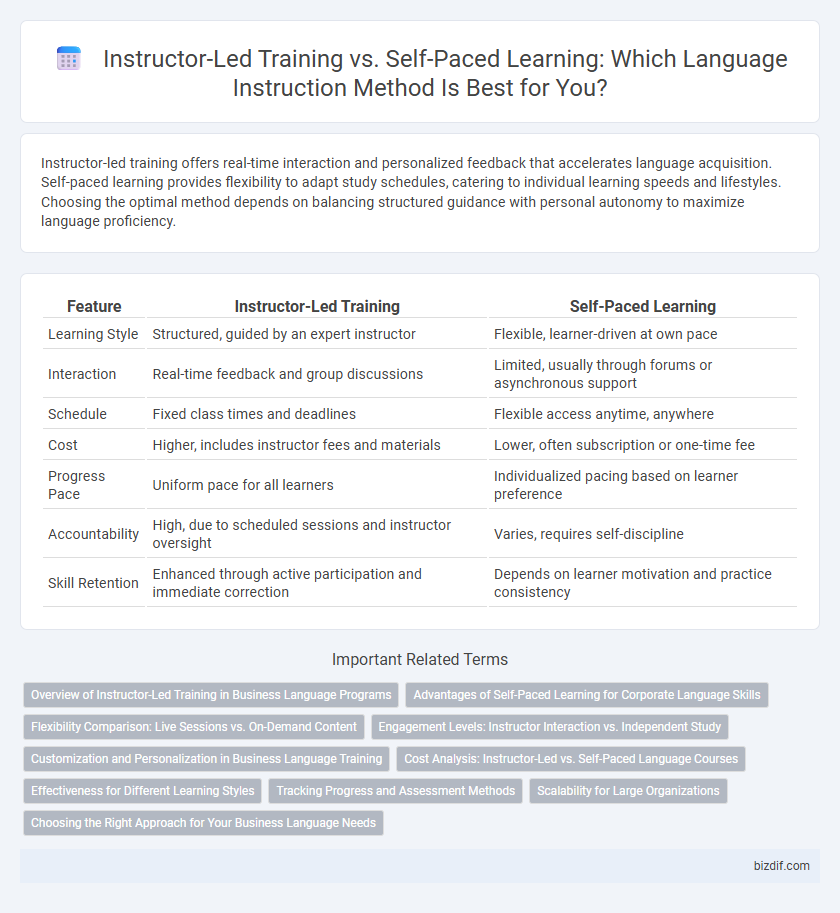Instructor-led training offers real-time interaction and personalized feedback that accelerates language acquisition. Self-paced learning provides flexibility to adapt study schedules, catering to individual learning speeds and lifestyles. Choosing the optimal method depends on balancing structured guidance with personal autonomy to maximize language proficiency.
Table of Comparison
| Feature | Instructor-Led Training | Self-Paced Learning |
|---|---|---|
| Learning Style | Structured, guided by an expert instructor | Flexible, learner-driven at own pace |
| Interaction | Real-time feedback and group discussions | Limited, usually through forums or asynchronous support |
| Schedule | Fixed class times and deadlines | Flexible access anytime, anywhere |
| Cost | Higher, includes instructor fees and materials | Lower, often subscription or one-time fee |
| Progress Pace | Uniform pace for all learners | Individualized pacing based on learner preference |
| Accountability | High, due to scheduled sessions and instructor oversight | Varies, requires self-discipline |
| Skill Retention | Enhanced through active participation and immediate correction | Depends on learner motivation and practice consistency |
Overview of Instructor-Led Training in Business Language Programs
Instructor-led training in business language programs offers structured, real-time interaction with expert instructors, enabling immediate feedback and personalized guidance to enhance language acquisition. This approach fosters collaborative learning through group discussions, role-playing, and practical exercises, crucial for mastering industry-specific terminology and communication skills. It is particularly effective for professionals needing consistent schedules and accountability to achieve proficiency within set timelines.
Advantages of Self-Paced Learning for Corporate Language Skills
Self-paced learning offers flexibility for corporate employees to master language skills without disrupting work schedules, enabling personalized pacing and review. This approach enhances retention through tailored content repetition, catering to diverse proficiency levels and learning styles across multinational teams. Cost efficiency and scalability make self-paced modules ideal for global corporations aiming to standardize language training and accelerate employee onboarding.
Flexibility Comparison: Live Sessions vs. On-Demand Content
Instructor-led training offers structured schedules with live sessions that promote real-time interaction, benefiting learners who thrive on immediate feedback and guided support. Self-paced learning provides unmatched flexibility through on-demand content accessible anytime, accommodating varied personal schedules and learning speeds. Learners seeking adaptive timing and control over their progress often prefer self-paced options, while those valuing direct engagement choose instructor-led formats.
Engagement Levels: Instructor Interaction vs. Independent Study
Instructor-led training offers high engagement levels through real-time instructor interaction, enabling immediate feedback, personalized guidance, and dynamic discussions that enhance language acquisition. Self-paced learning emphasizes independent study, allowing learners to progress at their own speed but often lacking the motivational boost and tailored support found in instructor-led environments. Balancing structured instructor interaction with flexible self-paced modules can optimize engagement and improve language proficiency outcomes.
Customization and Personalization in Business Language Training
Instructor-led training offers tailored content and real-time feedback, enabling precise customization to individual business language needs and learning styles. Self-paced learning provides flexible scheduling and adaptive resources, allowing personalization through user-controlled pacing and targeted practice modules. Combining both methods enhances overall language proficiency by balancing structured guidance with autonomous skill development.
Cost Analysis: Instructor-Led vs. Self-Paced Language Courses
Instructor-led language courses typically incur higher costs due to expenses related to qualified instructors, scheduling, and physical or virtual classroom infrastructure. Self-paced learning platforms reduce overhead by providing pre-recorded materials and automated assessments, often delivering more affordable options for learners. Evaluating long-term value requires balancing initial cost savings of self-paced formats against potential benefits of personalized guidance found in instructor-led training.
Effectiveness for Different Learning Styles
Instructor-led training offers personalized interaction and immediate feedback, which benefits kinesthetic and auditory learners who thrive in structured environments. Self-paced learning caters to visual and reflective learners by allowing control over the pace and revisiting complex materials. Combining both methods maximizes effectiveness by addressing diverse learning preferences within language instruction.
Tracking Progress and Assessment Methods
Instructor-led training offers real-time tracking of learner progress through direct observation and immediate assessment feedback, enabling personalized interventions based on performance data. Self-paced learning relies on digital platforms that automatically record completion rates, quiz scores, and time spent on modules, allowing learners to monitor their own advancement and educators to gather analytics remotely. Both methods utilize formative and summative assessments, but instructor-led training often incorporates dynamic, interactive evaluations, whereas self-paced learning emphasizes automated, standardized testing tools.
Scalability for Large Organizations
Instructor-led training provides structured, real-time interaction that enhances engagement but often faces scalability challenges in large organizations due to limited instructor availability and scheduling constraints. Self-paced learning offers flexibility and easy deployment across extensive teams, supporting scalability with consistent content delivery and allowing learners to progress independently at their own pace. Leveraging digital platforms for self-paced modules ensures efficient resource allocation and accommodates diverse learner needs within large organizational environments.
Choosing the Right Approach for Your Business Language Needs
Businesses selecting language instruction should weigh Instructor-Led Training against Self-Paced Learning based on factors like employee schedules, learning styles, and budget constraints. Instructor-Led Training offers personalized feedback and real-time interaction, ideal for developing conversational skills and immediate clarification. Self-Paced Learning provides flexibility and scalability, allowing learners to progress independently, making it a cost-effective solution for diverse workforce needs.
Instructor-Led Training vs Self-Paced Learning Infographic

 bizdif.com
bizdif.com